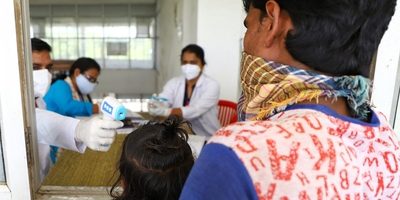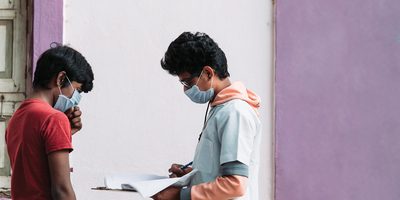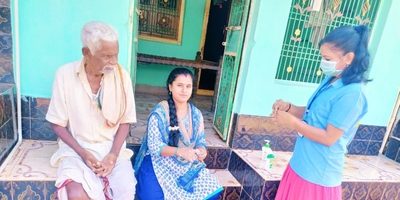
The urgent need to use a health systems approach in the COVID-19 battle in India
On World Health Day 2020, Dr. Soumyadeep Bhaumik writes about the urgent need to use a health systems approach in the COVID-19 battle in India.
The Government of India had last week announced a stringent 21-day lockdown in a bid to scale-up its response to control COVID-19. The Ministry of Health and Family Welfare maintains there is no evidence of community spread. There are many opinions on the way forward for COVID-19 control across the world. A hand-rule though guides all of it: “in a pandemic, prepare for the worst”. The worst in this case being community transmission ultimately leading to COVID-19 becoming endemic. How extensive will community transmission be is debatable- but there is consensus that it will bad. Bad enough that the country has decided to stop itself entirety for three weeks.
Lockdown 21: what is happening now
The 21-day lock-down has bought us crucial time: time for extensive contact tracing; time to ramp up testing, and; most crucially time to prepare our health system. Many commentators have talked about tracing and testing so, in this piece, we take a health systems approach to look at the issue.
The Indian strategy with regards to health system preparedness has borrowed heavily from what other countries have done so far. For brevity, it consists of ramping up capacity of intensive care units (ICU), acquiring more ventilators, and increasing the capacity for isolation. The modality of this has been earmarking separate COVID-19 hospitals, mostly by emptying existing ones. In some states ICU beds and ventilators are also being reserved in “non-COVID” hospitals as a surge capacity. Railway coaches & stadia are being converted to isolation wards too. All this is being done at a lightning speed, but we need to reflect on the vertical nature of this approach and its consequences.
Even in normal times, tertiary care facilities in India, be it public or private are full to the brim. Patients are refused admission and doctors are constantly triaging. Other than for elective procedures, no one is admitted to hospitals in a non-essential basis. At this hour, where did all these patients go? Where are they getting treated? People do not stop having strokes because of a pandemic! With a lockdown in place, people from rural areas are also constrained by the logistics of visiting far-flung sub-divisional district hospitals and medical colleges. How will chronic kidney disease patients reach day-care dialysis centres? The whole idea of fighting a pandemic is to save lives.
If deaths ‘due to COVID-19’ is prevented at the cost of deaths ‘because of COVID-19’, the lockdown is futile.
The ground reality remains that the bulk of care provided in secondary and tertiary care hospitals (which suddenly have decided to shun every other condition) is expected to shift to the primary health care system. Most doctors (including family physicians) in private practice have “closed shops” for fear of COVID-19. The primary health centres (PHCs), be it rural or urban, are running a skeletal service, if at all. The government has engaged community health workers (ASHAs, AWWs) as the ground force for contact tracing (named as field surveillance in government documents) with little thought about other essential service delivery. We are already seeing consequences for maternal and child health care and others will unfortunately follow suit.
The Government has also brought a guideline for telemedicine. From a health systems perspective starting a “game-changing” program in the midst of a pandemic seems challenging. Do doctors and patients have the digital competency required for this purpose? Do we have the structure to ensure that reasonable quality of care is being provided? Telemedicine might further drive health inequity – have we thought this through?
When community transmission strikes: the worst-case scenario
If we do enough testing, we will be able to detect community transmission early. If we do not, we will be detecting it about a couple of weeks later when death rates spike up. With two-thirds of the lockdown already over, and number of COVID-19 cases increasing, it is increasingly clear that many states will have to buy more time. In areas where community transmission happens, further lockdowns (of 14-28 days) will have to be enforced. This might be at the state-level, district level or even city/village level depending on how extensive the community transmission is. For India, not preparing for worst case scenario, might mean millions dying. Do we want to risk a humanitarian crisis of such magnitude?
The entire apparatus we are setting up in our tertiary care set-up to manage COVID-19 patients is downstream. What is upstream is contact tracing and testing. We are faltering because of lack of community awareness and stigmatisation of COVID-19. Contacts being untraceable or hiding would show later as spikes in death rates, when it is too late. There is an urgent need for community level awareness and anti-stigma interventions to ensure acceptance of contact tracing which community health workers can effectively deliver. Evidence from previous pandemics clearly indicate that this is crucial and instead of community health workers, a separate cadre (potentially government servants from non-essential services, who are now sitting in their homes and are being paid salaries) should be used for contact tracing instead of community health workers who are needed to deliver essential health care service.
The gargantuan task of preparing our tertiary care system is being brilliantly spearheaded by the Ministry of Health & Family Welfare, with entire nation contributing to it. Around 50,000 ventilators will be available in the system within a span of few weeks. But do we have enough doctors, nurses and other staff in the tertiary care set-up to run them? It is important to realise only a tiny fraction of doctors know how to optimally use ventilators. In Italy, 20% of health-care workers were infected, meaning they are either quarantined for weeks (if mild) , or hospitalised or they die. With reports from entire country on the lack of personal protective equipment (PPE) coming up, the loss of indispensable workforce is not acceptable. Without PPE and other micro-planning initiatives, entire hospitals will be shut (some of which is already happening) . We will be left with millions wasted on ventilators but no one to run it!
To add a bit more of perspective, even in non-pandemic scenario people die because of lack of oxygen. This is the time to invest proportionately using health systems approach and not go on a frenzied spending spree based on eminence-based inputs. This would mean calibrating spending on human resources, infrastructure, equipment and health workers, as well as addressing the social determinants to health. We need to calculate and declare state-wise projected requirements and corresponding availability in a dashboard. A battle needs a strategy – what we have instead are separate documents being put up every day from various agencies. The good thing is unlike a battle between armies, the document can be made public. This will sooth nerves and stop panic and speculation.
From what we have seen even in other countries, in its exponential phase COVID-19 rapidly overburdens tertiary care. In Paris (which has a capacity of 1200 intensive care beds: and many times smaller population than many Indian cities where COVID-19 only hospitals are being set up) we are seeing that the government has to now use the high speed Trains à Grande Vitesse to transport patients to other smaller cities now. Is there any learning for the world to take on how to manage pandemics?
PHCs are already at the helm of spearheading response at the community level. This needs to be acknowledged and we need to ensure preparedness through better governance and investment. The COVID-19 PHC Action Group , a voluntary collaborative of clinicians and public health professionals has identified six crucial domains for PHC preparedness. We need to start with immediate provision of medical-grade personal protective equipment (no jugaad please!), training on infection prevention and control and appropriate use of personal protective equipment in PHCs.
Ensuring patient safety is key and we need to ensure physical distancing and segregation. We might need to build additional infrastructure for isolation as well as management in PHCs. Medicines, equipment and supplies need to be stocked up to brave the storm when logistics will be a challenge. If we are serious about the potential of telemedicine, we need workforce, infrastructure, training and awareness for this in the primary care system. A pandemic with lives and livelihoods at stake is the worst time to expect reliable and robust service delivery based on volunteers only. Battles are not won by volunteer armies!
The endgame for COVID-19
At this point, we do not know how exactly COVID-19 will end. What we however know is, that it is not a sprint for few weeks, but a marathon for months. Vertical tertiary care models are not only unsuitable for our purpose but have also not worked in other countries. Most individuals with COVID-19, do not need intensive care and it might be important to think how they can be managed in rural PHCs. Our system perhaps cannot manage transferring patients back and forth for months. The current strategy of investing everything in “COVID hospitals” needs a hard look.
Without a health systems approach for pandemic control, we will see a sharp rise in overall deaths, disability and suffering. It clearly defeats the raison d'etre for the lockdown. There are challenges and barriers which can be clearly anticipated and be acted upon instead of being taken off the guard later and being apologetic.





